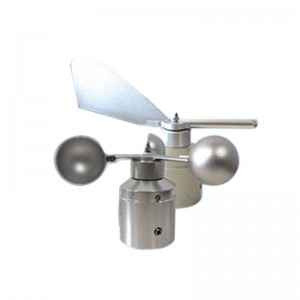Izici zezisetshenziswa kanye nokuqanjwa okusha kwezobuchwepheshe
Njengesisetshenziswa esibalulekile sokuqapha imvelo yesimanje, i-anemometer ye-aluminium alloy yenziwe nge-aviation-grade 6061-T6 aluminium alloy, futhi ifinyelela ukulingana okuphelele phakathi kwamandla esakhiwo nokukhanya ngobuchwepheshe bokucubungula ukunemba. Umnyombo wayo uqukethe iyunithi yezinzwa enezinkomishi ezintathu/i-ultrasonic, imojula yokucubungula isignali nohlelo lokuvikela, futhi inezici ezilandelayo ezivelele:
Ukuzivumelanisa nezimo ezibucayi
-60 ℃~+80℃ uhla lokushisa olubanzi ukusebenza (ozikhethela self-heating deicing module)
Izinga lokuvikela le-IP68, lingamelana nesifutho sikasawoti kanye nokuguguleka kothuli
Ibanga elinamandla limboza u-0~75m/s, futhi isivinini somoya sokuqala siphansi njengo-0.1m/s
Ubuchwepheshe benzwa obuhlakaniphile
Inzwa enezinkomishi ezintathu isebenzisa ubuchwepheshe bokufaka ikhodi kazibuthe obungathinteki (isixazululo esingu-1024PPR)
Amamodeli e-Ultrasonic abona ukulinganiswa kwe-vector enezinhlangothi ezintathu (ukunemba kwe-XYZ kwe-axis emithathu ±0.1m/s)
I-algorithm yesinxephezelo esakhelwe ngaphakathi sezinga lokushisa/umswakama (ukulinganisa okulandelekayo kwe-NIST)
Isakhiwo sokuxhumana sezinga lezimboni
Isekela i-RS485Modbus RTU, 4-20mA, ukuphuma kwe-pulse nokunye ukuxhumana kwe-multi-protocol
Imojula yokudlulisela engenantambo ye-LoRaWAN/NB-IoT (ibanga eliphezulu lokudlulisela elingu-10km)
Imvamisa yesampula yedatha ifika ku-32Hz (uhlobo lwe-ultrasonic)
I-Aluminium alloy anemometer diagram
Ukuhlaziywa kwenqubo yokukhiqiza ethuthukisiwe
Ukubumba igobolondo: ukujika kwe-CNC okunembayo, ukwenziwa ngcono komumo we-aerodynamic, ukuphazamiseka kokumelana komoya okuncishisiwe.
Ukwelashwa okungaphezulu: i-anodizing eqinile, ukumelana nokugqoka kukhuphuke ngo-300%, ukumelana nesifutho sikasawoti 2000h.
Ukulinganisa ibhalansi enamandla: isistimu yokulungiswa kwebhalansi ye-laser, i-vibration amplitude <0.05mm.
Ukwelashwa kokubeka uphawu: I-fluororubber O-ring + isakhiwo esingangeni manzi se-labyrinth, sifinyelela izinga lokuvikela ukujula kwamanzi angu-100m.
Izimo ezijwayelekile zezicelo zemboni
1. Ukusebenza kwamandla omoya ogwini lolwandle nokuqapha ukulungiswa
I-aluminium alloy anemometer array esetshenziswe e-Jiangsu Rudong wind farm offshore yakha inethiwekhi yokubuka enezinhlangothi ezintathu embhoshongweni ubude obungama-80m:
Kusetshenziswa ubuchwepheshe bokulinganisa komoya obuyi-ultrasonic-dimensional three-dimensional ukuze uthwebule i-turbulence intensity (i-TI value) ngesikhathi sangempela
Ngokudluliswa kweziteshi ezimbili ze-4G/satellite, imephu yenkundla yomoya ibuyekezwa njalo ngemizuzwana emi-5
Ijubane lokuphendula le-yaw system ye-wind turbine yaw system likhuphuka ngo-40%, futhi ukukhiqizwa kwamandla ngonyaka kukhuphuka ngo-15%
2. Ukuphathwa kokuphepha kwechweba elihlakaniphile
Uhlelo lokuqapha isivinini somoya olungaqhumi olusetshenziswa e-Ningbo Zhoushan Port:
Ihambisana nesitifiketi se-ATEX/IECEx sobufakazi bokuqhuma, esifanele izindawo zokusebenza zempahla eyingozi
Uma isivinini somoya singu->15m/s, okokusebenza kwe-crane yebhuloho kuyakhiywa ngokuzenzekelayo futhi idivayisi yokunamathisela ixhunywe.
Ukunciphisa izingozi zokulimala kwemishini ebangelwa umoya onamandla ngo-72%
3. Uhlelo lokuxwayisa kwezokuthutha ngojantshi kusenesikhathi
I-anemometer ekhethekile efakwe engxenyeni ye-Tanggula ye-Qinghai-Tibet Railway:
Ifakwe idivayisi kagesi yokushisisa i-deicing (isiqalo esivamile ku -40 ℃)
Ixhunywe nesistimu yokulawula isitimela, isivinini somoya > 25m/s sicupha umyalo womkhawulo wesivinini
Ixwayise ngempumelelo u-98% wezinhlekelele zesiphepho sesihlabathi/isiphepho
4. Ukulawulwa kwemvelo emadolobheni
Isigxobo sokuqapha ukuxhumanisa isivinini somoya se-PM2.5 esikhuthazwa ezindaweni zokwakha zaseShenzhen:
Lungisa ngamandla ukusebenza kwezinganono zenkungu ngokusekelwe kudatha yesivinini somoya
Khulisa ngokuzenzakalelayo imvamisa yokufafaza lapho isivinini somoya > 5m/s (ukonga amanzi 30%)
Yehlisa ukusabalala kothuli lokwakha ngo-65%
Izixazululo ezikhethekile zesimo
Ukusetshenziswa kweziteshi zocwaningo lwesayensi ye-polar
Isixazululo esenziwe ngokwezifiso sokuqapha isivinini somoya se-Kunlun Station e-Antarctica:
Adopt titanium alloy abakaki abaqinisiwe kanye nesakhiwo esiyinhlanganisela ye-aluminium ingxubevange yomzimba
Ilungiselelwe nge-ultraviolet defrosting system (-80 ℃ izimo zokusebenza ezidlulele)
Thola ukusebenza okungagadiwe unyaka wonke, izinga lobuqotho bedatha > 99.8%
Ukuqapha ipaki yamakhemikhali
Inethiwekhi esabalalisiwe ye-Shanghai Chemical Industrial Park:
Njalo ngo-50 0m ekuphakanyisweni kwamanodi ezinzwa ezilwa nokugqwala
Ukuqapha isivinini somoya/indlela yomoya phakathi nokuvuza kwegesi ye-chlorine
Isikhathi sokuphendula esiphuthumayo sifinyelelwe kumaminithi angu-8
Isiqondiso sokuziphendukela kwezobuchwepheshe
I-Multi-physics field fusion perception
Isivinini somoya esididiyelwe, ukudlidliza, kanye nemisebenzi yokuqapha ingcindezi ukuze kutholakale ukuhlonzwa ngesikhathi sangempela kwesimo sezempilo se-wind turbine blade
Digital twin isicelo
Misa imodeli yokulingisa enezinhlangothi ezintathu zenkundla yesivinini somoya ukuze unikeze isibikezelo sokunemba kwezinga lesentimitha ekukhethweni kwesayithi elincane lamapulazi omoya
Ubuchwepheshe bokuzenzela
Yakha idivayisi yokuvuna amandla e-piezoelectric ukuze uzuze okokusebenza okuzisebenzelayo usebenzisa ukudlidliza okubangelwa umoya
Ukutholwa okudidayo kwe-AI
Sebenzisa i-LSTM neural network algorithm ukuze ubikezele ukushintsha kwesivinini somoya kungazelelwe amahora angu-2 kusengaphambili
Ukuqhathaniswa kwamapharamitha wobuchwepheshe ajwayelekile
| Isimiso sokulinganisa | Ibanga (m/s) | Ukunemba | Ukusetshenziswa kwamandla | Izimo ezisebenzayo |
| Omakhenikha | 0.5-60 | ±3% | 0.8W | Ukuqapha isimo sezulu esijwayelekile |
| I-ultrasonic | 0.1-75 | ±1% | 2.5W | Amandla omoya/indiza |
Ngokuhlanganiswa kwezinto ezintsha nobuchwepheshe be-IoT, isizukulwane esisha se-aluminium alloy anemometers siyathuthuka siqonde ku-miniaturization (ubukhulu obuncane obungama-28mm) kanye nobuhlakani (amakhono wekhompiyutha onqenqemeni). Isibonelo, imikhiqizo yakamuva yochungechunge lwe-WindAI, ehlanganisa iphrosesa ye-STM32H7, ingaqedela ukuhlaziya isivinini somoya endaweni yakini, inikeze izixazululo ezinembe kakhulu zombono wendawo ezimbonini ezihlukahlukene.
Isikhathi sokuthumela: Feb-12-2025


